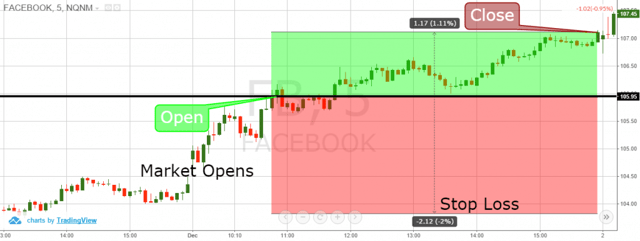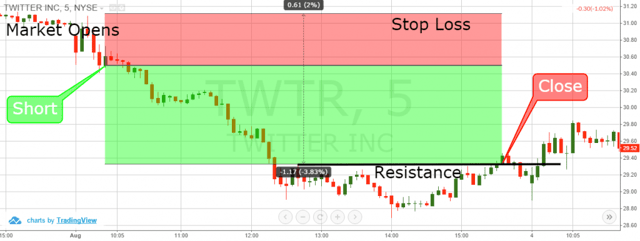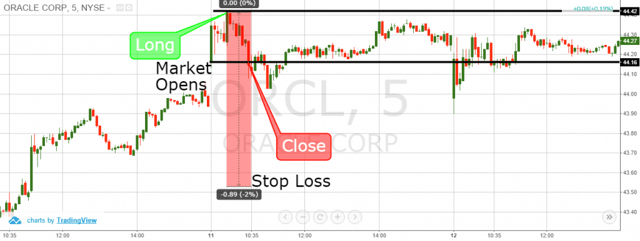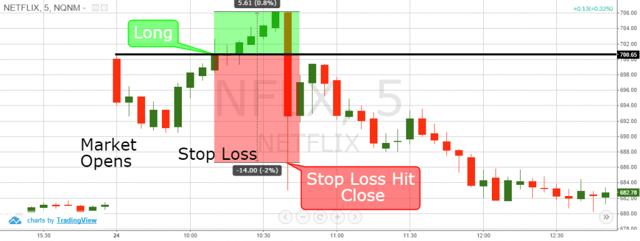Day Trading Money Management
Day trading as a business can be very profitable. It is probably the safest form of investing, as you are focusing on a small number of positions, you are not holding any positions overnight and you are able to enter and exit trades with pinpoint accuracy. However, many day traders find themselves losing due to poor day trading money management.
How Much Should You Risk
The size of your trading position, is in direct proportion to the value of your portfolio. The key to day trading success is to avoid big losers. I can not tell you how many times early in my trading career, that I would be up huge over a 5-day period, only to have a big loser wipe out 50% of my gains. So, to avoid this bad habit, you should only risk a total of 1% of your portfolio on any one trade. Most traders take this rule of thumb, and just put a 1% stop loss out there and when that is hit, they just take the loss. If you have put on around 1,000 day trades or more, you know all too well that a 1% loss can happen. So, in order to avoid taking constant hits, you should allow yourself to take a 2% hit on your position, where the dollar loss from this trade will only represent 1% of your overall account value. Now that I have confused both of us, let me try to say that a little easier. You simply want the total dollar amount invested per position, to equate to 12.5% of your total marginable equity. So, if your account value is $100,000 you will have $400,000 dollars in margin buying power, and should use $50,000 for each trade. Remember, this $50,000 you use only represents 12.5% of your marginable equity. This way if you take a 2% hit, it will only be 1% of your total account value.
Stops are not meant to be hit
It really upsets me when I hear so-called professionals advise new traders to set stop loss amounts. Doesn’t that seem like a general rule? Trading is a game of precision, and does not operate in the realm of gray. Yes, you need a stop loss order for every trade, but it is a fail-safe. In this article we have discussed the power of a 2% stop rule and overall day trading money management. But do you think you should let every losing trade hit your stop? Of course not. Now I am not suggesting that we all become rogue traders and trade without stops. The minute you see that the trade is wrong, get out with small hit. Because in the end, the goal here is to see a small number of .25% or .5% losses, while your winners are in the range of 1%-3%. This is how you will win the game. Again, the 2% stop loss is for the unexpected sharp counter move, and it is not your goal to have this stop hit. You should know well before your stop is hit if you are in a bad trade.
Operate in Cash
Day trading is a cash business. The only loan you should be using is with your day trading margin buying power. Do not start or continue to day trade, if you have to take out loans, credit, or use part of your retirement to get in the game. Traders that operate with a positive cash flow and utilize day trading money management rules have a much higher success rate than traders that start out in the red.
Money Management Trading Examples
Since we have covered basic money management rules in trading, let us now explore a few real-world examples.
First, let us dive a little further into the money management rule of limiting losses on each trade to 1% of your overall bankroll.

Money Management Trading Example
This is the 5-minute chart of Facebook from Dec 1, 2015.
Facebook opens with a bullish gap. The price eventually tops out around $105.63 and then begins a correction.
For this reason, we use $105.63 as a trigger for a long position, as a breach of this level could lead to another run up in the stock.
The price breaks $105.63 and we were able to enter the market long at $105.95. Assuming our cash account has $100,000, since we are day trading, we can leverage 4 times this amount.
This means that with $100,000, we have buying power of $400,000. We invest $50,000 in the trade and place our stop loss order 2% from our entry price to limit the total impact to our cash portfolio to 1%.
Let’s calculate:
50,000 x 0.02 = 1,000
This means we are risking a maximum of $1,000 on the trade, which is 1% of our total cash balance.
Now, let’s shift gears back to the trade.
The red area on the image represents where we would be down on the position and at the bottom of this area is our stop, which is $2.12 from our entry price.
After we go long, Facebook begins moving upwards as forecasted. On its way up, Facebook has a few corrections.
However, we stay in the trade because none of these corrections breaks one of the previous bottoms. We exit our long position before the market closes to avoid holding an overnight position.
We exited the trade $1.17 higher than our entry price, which represents a 1.11% increase on our position.
Let’s now perform some basic arithmetic:
$50,000 x 0.0111 (1.11%) = $555 profit.
So, to quickly recap, our $100,000 bankroll grew to $100,555 ($100,000 + $555). Therefore, our buying power increased to $402,220.
Notice that this trade brought us 1.11% while risking 2%, which does not give us a good risk-to-return ratio. Therefore, you will want to have a high winning percentage in your trading system, if your gains are relatively small.
Let’s review another example:
Winning Trade

Stop Loss Example
Here we have the 5-minute chart of Twitter from Aug 3, 2015. In this scenario, we will use the same money management rules in trading, but on a short position.
Twitter begins the trading day with a bearish gap. The gap is followed by a contrary bullish move, which creates a bottom. The price starts decreasing afterward and we use that bottom as a trigger for a short position.
Once this low is breached, we take a short trade.
Remember, that we increased our capital to $100,555, which gives us buying power of $402,220. Since we invest 12.5% of our buying power in each trade, we use $50,277.50 on the trade.
Our stop loss order is located 2% higher from our entry price, thus we are risking a maximum of $1,005.55 in the trade.
The price starts moving downwards in earnest after we short Twitter. After two and a half hours of consolidating, Twitter finally started to move upwards and we exited our position.
So, what were the results of this trade?
This time, we entered the trade with $50,277.50, because we increased our capital and buying power from the previous trade. We risked 2% of the amount traded, which equals 1% of our capital – $1,005.55.
This time, the trade was more than three times better than our first one. We managed to catch a 3.83% price decrease while shorting Twitter. So, let’s calculate:
$50,277.50 x 0.0383 = $1,925.63 profit from shorting Twitter!
In this manner, our capital will increase to $102,480.62 ($100,555 + $1,925.63) and our buying power will increase to $409,922.51 ($102,480.62 x 4).
Losing Trade

Losing Trade Example
This is the 5-minute chart of Oracle from Jun 11, 2015. In the image above, we take a long position that ends up failing.
Oracle begins the trading day with a bullish gap, and 30 minutes later, Oracle’s price makes a new high and we enter a long position.
This is our third trade and until now, we have increased our capital to $102,480.62, which gives us buying power of $409,922.51. We continue investing 12.5% of our buying power, which breaks down to the following:
409,922.51 x 0.125 = $51,240.31
We go long buying $51,240.31 of Oracle at $44.42 per share. As usual, we put a stop loss order 2% below our entry price at $43.27.
Once in the trade, Oracle never gets going and begins to roll over.
The price breaks $44.16, which marks the open price of the starting gap candle. This gives us a signal that the price action is not going in our favor and we decide to exit the trade.
We end up losing $299.92 from this trade, instead of $1,024.81 had we have waited until the stop loss was hit. When we subtract this loss, we end up with cash account value equal to 102,180.70.
Do you remember when I said earlier in the article that stops are not meant to be hit? This is exactly what I mean.
Why should you stay in a trade, which obviously is not moving in your favor? After all, the 2% stop is just for unpredictable and volatile situations. That does not mean that every losing trade should cost you 1% of your bankroll.
Now, I will show you a situation where your stop loss is the only thing protecting you from the bread line.
When Volatility is not Your Friend

Stop Loss Losing Example
This is the 5-minute chart of Netflix from Jun 24, 2015. Above you see an unsuccessful long position, where our 2% stop loss was triggered.
For twenty-five minutes, Netflix goes in our desired direction and we were actually up 0.8%! However, the sixth candle after our long position takes a sad turn for the worst. Netflix price crashes 3.25% in a matter of seconds! Fortunately, we had our 2% stop loss, which prevented us from taking a steep hit.
So, if we continue on our trading journey in this article, here are the results of the trades highlighted in this article:
We invested $51,090.35 to purchase 73 Netflix shares. The price hits our 2% stop loss order and we lose $1,021.81 from this trade. Therefore, our bankroll decreases to $101,158.89 (102,180.70 – 1,021.81).
Hey! Even after these two terrible trades, we still have more than $100,000! We are still in the game!
This my friends, over thousands of trades is how you slowly but surely get ahead in this the greatest of all games.
Isn’t the 1% Rule Too Expensive?
Absolutely not! These rapid price moves do not happen in every trade. Actually, a 3.25% decrease in a minute as in the example above is a relatively rare event. However, when it happens, we should be prepared.
Remember, you need to use your own system to know when to exit a trade. If you see the price moving against you and things don’t feel right, simply get out of there. As I previously stated, stops are not meant to be hit if you are keeping your eye on the ball.
Conclusion
- Money Management is considered the most important aspect when day trading.
- If you do not implement a day trading money management technique, you will inevitably lose your money.
- Your 2% stop loss is not meant to be hit! It is there to protect you from huge price moves.
- Attempt to close all your losing trades before the 2% stop loss is triggered if anything feels out of place.











 Day Trading Basics
Day Trading Basics 
